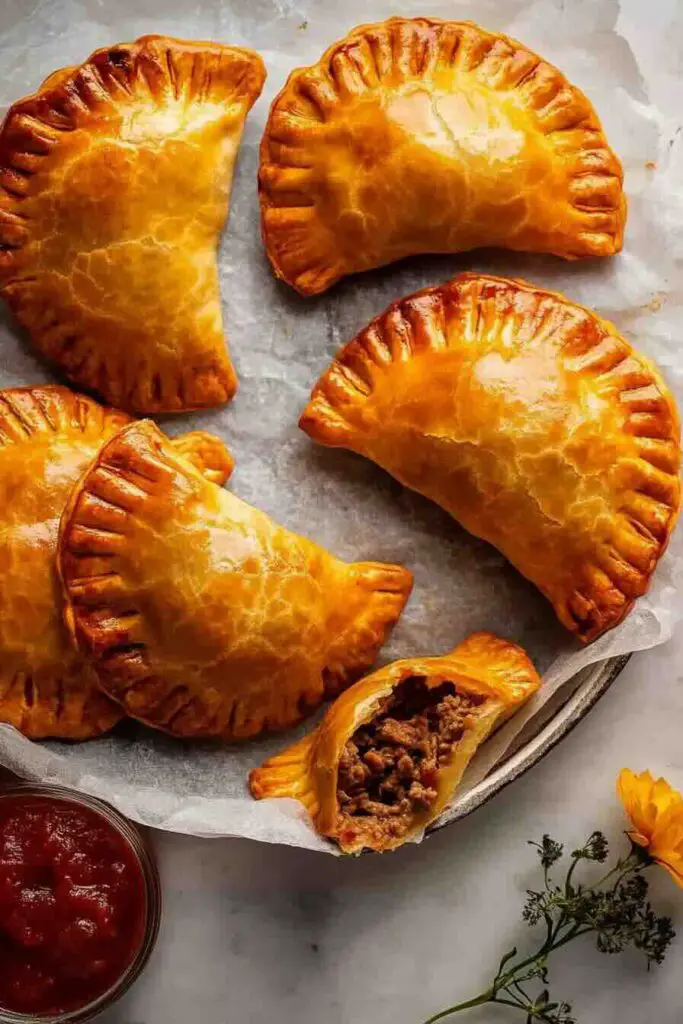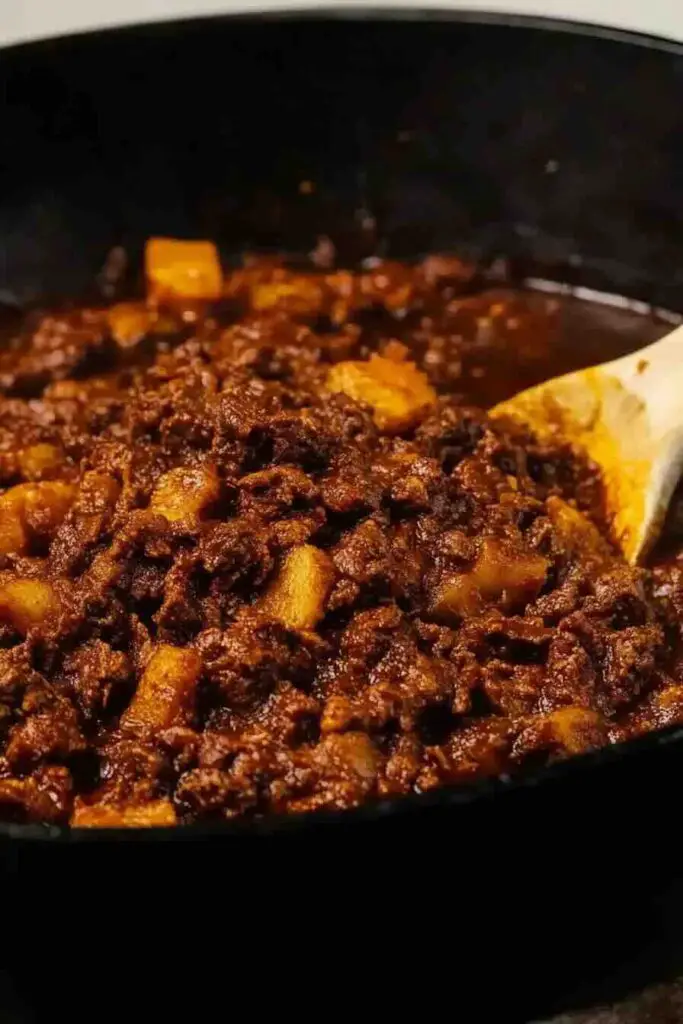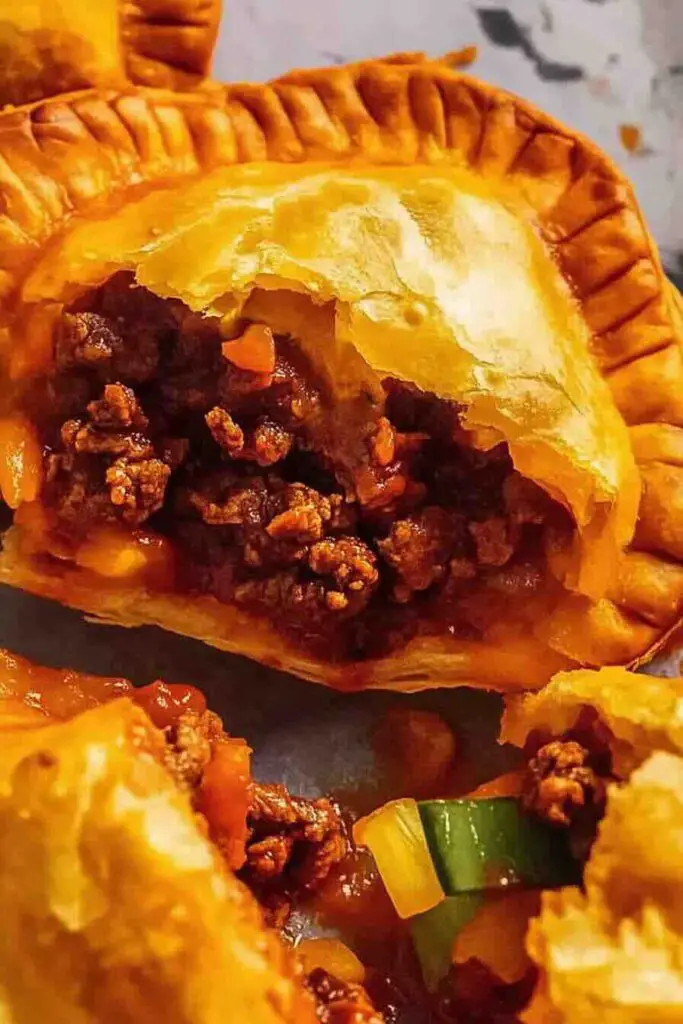Introduction
Ahhh, empanadas. Just saying the word makes my stomach rumble! These golden, crispy, flavor-packed pockets of joy are a staple in so many cultures—and for good reason! Whether they’re baked to perfection or fried into crispy bliss, empanadas are the kind of comfort food that hugs you from the inside out.
I still remember my first bite of a freshly made empanada—flaky crust, juicy filling, a hint of spice, and that perfect balance of crunch and chew. I was hooked! And ever since, I’ve been on a mission to perfect the ultimate empanada recipe.
But here’s the best part: empanadas aren’t just delicious, they’re also crazy versatile! Stuff ‘em with meat, cheese, veggies, or even something sweet—the possibilities are endless. And the best part? They’re surprisingly easy to make! Whether you’re a kitchen newbie or a seasoned cook, once you master the basics, you’ll be cranking out homemade empanadas like a pro.

So, let’s get into it—everything you need to know about empanadas, from their history to pro tips, plus a foolproof recipe that’ll have you making them on repeat!
Reasons You’ll Love This Recipe
I could probably list a hundred reasons, but let’s keep it snappy! Here’s why you NEED to try this empanada recipe:
- Super Easy to Make – Even if you’re new to the kitchen, you’ve got this! Trust me.
- Endlessly Customizable – Beef, chicken, cheese, veggies… even Nutella! You can go savory, sweet, spicy—whatever your heart desires.
- Great for Meal Prep – Make a big batch and freeze them for later. Dinner = sorted!
- Perfect for Any Occasion – Parties, snacks, lunchboxes, game day treats… there’s never a bad time for empanadas.
Basically, once you make these, you’ll wonder how you ever lived without them.
What Makes a Good Empanada?
Not all empanadas are created equal! A truly great empanada needs:
- Perfect Dough – It should be light, flaky, and crispy, but sturdy enough to hold the filling. No sad, soggy dough here!
- Flavorful Filling – Juicy, well-seasoned, and never dry. The right balance of moisture is KEY!
- The Right Seal – A solid seal ensures the filling stays inside and doesn’t leak out while cooking. Crimping or using a fork works wonders!
- Cooking Method Magic – Baking gives you golden crispiness with less oil, while frying takes the crunch factor to the next level. Both have their perks!
If you nail these, you’re in for an empanada that’s chef’s kiss perfect!
The Cultural Significance of Empanadas
Empanadas aren’t just a snack—they’re a whole vibe! They hold deep cultural significance in Latin America, Spain, and the Philippines. They’re the star of family gatherings, street food stalls, and festivals alike!
In Argentina, they are a must-have at parties. In the Philippines, they’re often filled with a sweet-savory mix and enjoyed as a hearty merienda (afternoon snack). And in Spain, where they originated, they’re part of centuries-old culinary traditions.
Basically, no matter where you go, empanadas tell a delicious story of heritage, family, and flavor!
A Brief History of Empanadas
So where did these little pockets of joy come from? Let’s take a trip back in time:
The Origins of Empanadas
It’s believed that empanadas originated in Spain, specifically in Galicia, during the Moorish occupation. They were inspired by Arabic pastries like samosas (yep, those crispy Indian delights!). The first written recipe? Found in a 1520 Spanish cookbook!
How Empanadas Spread Across the World
When Spanish colonizers set sail, empanadas hitched a ride! They made their way to Latin America and the Philippines, where they evolved based on local flavors. That’s why you’ll find them with beef and olives in Argentina, seafood in Chile, and even sweet ones in the Philippines!
Empanadas Today
Fast forward to today, and empanadas are EVERYWHERE. Street food, home-cooked meals, fancy restaurants—you name it. They’re a true global favorite!
Ingredients for Empanadas
For the Dough
- All-purpose flour
- Butter (cold!)
- Egg
- Salt
- Water
- Vinegar (yes, it helps with texture!)
For the Filling
Classic Beef Filling:
- Ground beef
- Onions & garlic
- Paprika & cumin
- Olives & hard-boiled eggs (optional, but traditional!)
Variations:
- Chicken, shrimp, or pork
- Cheese & veggies
- Sweet fillings like apple, cinnamon, or Nutella
Equipment You’ll Need
- Mixing bowls
- Rolling pin
- Pastry cutter or knife
- Baking sheet (if baking)
- Deep fryer or pan (if frying)
- Fork (for sealing)
Step-by-Step Instructions

1: Making the Dough
- Mix flour, salt, and butter until crumbly.
- Add egg, vinegar, and water; knead into a dough.
- Let it rest—it’s worth the wait!
2: Preparing the Filling
- Cook the meat, spices, and veggies until flavorful.
- Let it cool before assembling (this helps with sealing!).
3: Assembling the Empanadas
- Roll out dough, cut circles.
- Add filling, fold, and crimp the edges.
4: Cooking
- Baking: Brush with egg wash, bake until golden.
- Frying: Heat oil, fry until deep golden perfection.
How to Tell When Empanadas Are Done
Nothing is worse than biting into an empanada only to realize the dough is still raw or the filling isn’t quite right. So, how do you know when your empanadas are cooked to perfection? Let’s break it down based on the cooking method you choose.
For Baked Empanadas
If you’re baking, you’ll want to watch for a few key signs to ensure they’re fully cooked. First, the crust should turn a beautiful golden brown—no pale, undercooked dough here! The edges should look slightly crisp, and if you tap the empanada lightly, it should sound hollow rather than doughy.
A great trick to check for doneness is to look at the bottom of the empanada—if it’s golden brown and firm, you’re good to go! If it’s still soft and pale, let it bake for a few more minutes.
Another telltale sign? That irresistible smell! When your kitchen is filled with the mouthwatering aroma of baked dough and savory filling, chances are your empanadas are almost ready.
For Fried Empanadas
Frying them takes the crisp factor up a notch, but getting them just right requires a little know-how. Your empanadas should be a deep golden brown on all sides. If they’re still looking too pale, they need more time in the oil.
Be careful, though—overfrying can lead to a tough, overly crunchy crust. The key is to fry them just until they’re crispy on the outside but still tender inside. A good rule of thumb is about 2 to 4 minutes per side, depending on the size and thickness of your dough.
And here’s a pro tip: If your oil isn’t hot enough, your empanadas will absorb too much oil and turn greasy instead of crispy. Keep the oil temperature at around 350–375°F (175–190°C) for the best results!
Checking the Internal Temperature
If you want to be extra sure your empanadas are fully cooked, check the internal temperature with a food thermometer. The filling should reach at least 165°F (74°C) to ensure it’s safe to eat, especially if you’re using raw meat in your filling.
So, whether you bake or fry, watch for that golden color, crispy edges, and fully cooked filling, and you’ll have perfect empanada every time!
Variations & Toppings
One of the BEST things about empanadas? They’re ridiculously versatile! You can change up the fillings, experiment with different doughs, and even get creative with toppings and dipping sauces. Let’s take a look at some popular variations and tasty add-ons.
Regional Empanada Variations
Different countries have their own special take on empanadas, and each one is unique in flavor, texture, and ingredients.
- Argentine Empanadas – These are typically baked and filled with beef, onions, paprika, cumin, and sometimes olives or raisins. Some versions include hard-boiled eggs for extra richness!
- Chilean Empanadas – These are similar to Argentine empanada but often feature seafood, cheese, or a slightly sweeter dough.
- Filipino Empanadas – Filipino-style empanada use a slightly sweet, flaky crust and are commonly filled with shredded chicken or pork, carrots, and green papaya.
- Colombian & Venezuelan Empanadas – These are often made with corn-based dough instead of wheat flour and deep-fried for a crispier bite. The filling can range from shredded beef to black beans and cheese.
- Spanish Empanadas (Empanada Gallega) – Unlike the hand-held empanadas we’re used to, Spain’s version is often made as a large, pie-like dish filled with tuna, peppers, and tomatoes.
Tasty Toppings & Dips
Empanadas are already delicious on their own, but the right toppings or dips can take them to the next level!
- Chimichurri Sauce – This garlicky, herby sauce from Argentina is a match made in heaven for empanadas!
- Salsa or Guacamole – Fresh, tangy, and full of flavor—perfect for dipping!
- Spicy Aioli – A creamy, garlicky, spicy sauce that adds extra richness to every bite.
- Sour Cream or Greek Yogurt – If you want something cool and refreshing, a little sour cream or yogurt can balance out the bold flavors of the filling.
Whether you go traditional or put your own spin on things, there’s no wrong way to enjoy an empanada!
Nutritional Insights
Okay, let’s be real—empanadas aren’t exactly “health food,” but that doesn’t mean you can’t make a few tweaks to lighten them up!
Calories & Macronutrients
A classic beef empanada usually contains around 250–300 calories, with a mix of protein, fat, and carbs. The exact nutrition breakdown depends on the filling and cooking method. Fried empanadas tend to have more fat, while baked versions are slightly lighter.
Healthier Alternatives
If you’re looking for a more nutritious version, here are a few easy swaps:
- Whole Wheat Dough – Using whole wheat flour instead of all-purpose flour adds more fiber and nutrients.
- Air Frying Instead of Deep Frying – You’ll still get a crispy crust with way less oil!
- Lean Proteins – Opt for ground turkey, chicken, or plant-based fillings instead of fattier meats.
- Veggie-Packed Fillings – Adding spinach, mushrooms, or beans can up the fiber and nutrient content.
So, while empanadas are definitely a treat, they can be enjoyed in a balanced diet—especially when paired with fresh sides like a salad or grilled veggies!
Pro Tips & Tricks
Want to take your empanadas to the next level? Keep these tips in mind:
- For Perfect Dough: Keep your ingredients COLD, and don’t overwork the dough—it should be soft and easy to roll out.
- For Juicy Filling: Let the filling cool before assembling. Hot filling = soggy dough = disaster.
- For a Crispy Finish: Brush baked empanadas with egg wash before popping them in the oven for that irresistible golden glow.
- For the Best Seal: Use a fork to crimp the edges or try the classic “repulgue” fold (the fancy twist you see on traditional empanadas).
Once you master these tricks, you’ll be making empanadas like a pro in no time!

Storage & Health Tips
Homemade empanadas are SO good that they rarely last long, but if you do have leftovers, here’s how to store and reheat them.
How to Store Empanadas
- Fridge: Store cooked empanadas in an airtight container for up to 3–4 days.
- Freezer: Uncooked empanadas can be frozen for up to 3 months. Just place them on a baking sheet, freeze until firm, then transfer to a zip-top bag.
How to Reheat Empanadas
- Oven: The best method! Bake at 350°F (175°C) for about 10 minutes until crispy and warm.
- Air Fryer: A quick and easy way to get crispy empanadas—heat at 350°F (175°C) for 5 minutes.
- Microwave: Works in a pinch, but they might get a little soft. Heat in short bursts to avoid drying out the filling.
FAQs
What Are Empanadas Made Of?
Empanadas consist of a pastry shell filled with a variety of ingredients, commonly meat, cheese, vegetables, or even sweet fillings like fruit or chocolate.
Are Empanadas the Same as Cornish Pasties?
Not exactly! While both are stuffed pastries, Cornish pasties come from England and usually contain beef, potatoes, and onions, whereas empanadas have more diverse fillings and seasoning styles.
Are Empanadas from Spain or Mexico?
Empanadas originated in Spain but were brought to Mexico and other Latin American countries, where they evolved into different regional varieties.
Where Did Empanadas Originally Come From?
The earliest known empanadas trace back to Galicia, Spain, in the 1500s, influenced by Middle Eastern cuisine (think samosas!).
Before You Go…
Craving more goodness? Check out my recipe for Beef Enchiladas next. It’s just as comforting, indulgent, and easy to make. You’re going to love it! ❤️
Now go whip up some empanadas! You’re gonna LOVE them! 🎉🔥

Empanadas Recipe
- Prep Time: 30 minutes
- Cook Time: 25 minutes
- Total Time: 55 minutes
- Yield: 12 1x
Description
Crispy, golden, and packed with flavor—these homemade empanadas are the perfect comfort food! Whether baked or fried, these delicious hand pies are easy to customize with your favorite fillings. From traditional beef to cheesy vegetarian options, this foolproof recipe will have you making authentic empanadas like a pro!
Ingredients
For the Dough:
- 3 cups all-purpose flour
- 1 tsp salt
- ½ cup unsalted butter, chilled and cubed
- 1 large egg
- ½ cup cold water
- 1 tbsp white vinegar
For the Filling (Classic Beef):
- 1 tbsp olive oil
- 1 small onion, finely chopped
- 2 cloves garlic, minced
- ½ lb ground beef
- ½ tsp paprika
- ½ tsp cumin
- ½ tsp salt
- ¼ tsp black pepper
- ¼ cup green olives, chopped (optional)
- 1 hard-boiled egg, chopped (optional)
- 1 tbsp tomato paste
For Assembly & Cooking:
- 1 egg (for egg wash)
- 2 cups vegetable oil (if frying)
Instructions
Step 1: Make the Dough
- In a large bowl, mix flour and salt.
- Add the chilled butter and use your hands or a pastry cutter to mix until the texture resembles coarse crumbs.
- In a small bowl, whisk together the egg, water, and vinegar. Slowly pour into the flour mixture and mix until a dough forms.
- Knead the dough on a lightly floured surface for 2–3 minutes until smooth. Cover and refrigerate for at least 30 minutes.
Step 2: Prepare the Filling
- Heat olive oil in a pan over medium heat. Add onions and garlic, cooking until soft.
- Add ground beef, paprika, cumin, salt, and pepper. Cook until browned.
- Stir in tomato paste and cook for another 2 minutes.
- Remove from heat and mix in chopped olives and eggs, if using. Let the filling cool completely.
Step 3: Assemble the Empanadas
- Roll out the dough to about ⅛-inch thick. Cut into 4–5 inch circles using a cutter or small bowl.
- Place 1–2 tablespoons of filling in the center of each circle.
- Fold the dough over the filling, creating a half-moon shape. Press the edges with a fork or crimp for a decorative seal.
- Brush the tops with egg wash if baking.
Step 4: Cook the Empanadas
For Baking:
- Preheat oven to 375°F (190°C).
- Place empanadas on a baking sheet lined with parchment paper.
- Bake for 20–25 minutes or until golden brown.
For Frying:
- Heat vegetable oil in a deep pan to 350°F (175°C).
- Fry empanadas in batches for 2–3 minutes per side, until deep golden brown.
- Drain on paper towels.
Step 5: Serve and Enjoy!
Let the empanadas cool slightly before serving. Pair with chimichurri, salsa, or your favorite dipping sauce!
Notes
- Dough Substitutes: Store-bought pie crust or puff pastry can be used for a quick alternative.
- Filling Variations: Swap beef for chicken, shrimp, or vegetarian fillings like cheese and spinach.
- Make-Ahead: Empanadas can be frozen before cooking and baked/fried straight from the freezer.
Nutrition
- Calories: 280
- Sugar: 1g
- Sodium: 300mg
- Fat: 14g
- Saturated Fat: 5g
- Carbohydrates: 30g
- Fiber: 2g
- Protein: 9g
- Cholesterol: 45mg
